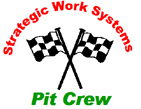Lean – What it is, What it isn’t
We have heard much about the concepts of “lean manufacturing” and the “lean organization” over the past few years. What is now known as “lean” is, for the most part, based on the proven models of the Toyota Production System in their plants around the world, including the plants in Indiana and Kentucky.
When many of today’s business leaders interpret “lean” as “downsizing,” they make the mistake of reducing headcount in their organizations to make them leaner from a staffing perspective. That is not the intent of “lean.”
What Lean Is
A fundamental characteristic of a lean organization or lean manufacturing is the systematic identification and elimination of waste to reduce manufacturing or operating costs. Many forms of waste are targeted, including wastes associated with overproduction, transportation, motion, inventory, processing, defects, and waiting. Unreliable equipment also represents a significant waste: extra inventory (safety stock) to compensate for breakdowns; extra (backup or in-line spare) equipment; processing delays due to unplanned downtime or inefficient performance; defective materials produced due to breakdowns; waiting for information, parts, and materials to make the needed repairs; or waiting caused by inefficient (slower) equipment operation. Eliminating equipment-related wastes or losses is fundamental to achieving the goals of “lean.” Total Productive Maintenance (TPM) is the element of the Toyota Production System that focused on eliminating equipment-related losses, or wastes in ways that improved throughput, reduced defects, and reduced maintenance costs.
What Lean Isn’t
If the organization’s leadership assumes that “lean” means fewer people and begins reducing headcount without eliminating, or at least reducing, the equipment-related waste, the cost spiral begins. We have seen it happen time and time again. With fewer people to respond to equipment problems or to perform the required preventive maintenance, the equipment performance levels and reliability suffer even more. This approach can actually increase the manufacturing or operating costs rather than reducing them.
Downsizing and lean are not the same. Downsizing without eliminating waste is typically not sustainable. Rather, it is a one-time, short-term cost reduction strategy that if left alone will likely lead to increased costs.
Techniques for Becoming Lean
So, what are the correct methods for becoming “lean” in a sustainable manner? Consider the roots of lean – the systematic identification and elimination of waste to reduce manufacturing or operating costs. Begin by focusing the organization on identifying the types, reasons, and root causes of waste that have a direct and immediate impact of the business performance. For equipment-related wastes, be sure to involve the people who are closest to the problems: maintenance and reliability (repairs and prevention), operations/production, purchasing/stores (repair parts), engineering/technical (design and modification). Identify and eliminate the causes of poor performance using formal problem identification and root cause analysis methods. This takes data. Some organizations have excellent data, which makes this step easier. In the absence of data, go with what you know. Baseline the targeted equipment performance measures and then begin collecting data to measure equipment performance and see if improvements are actually being made.
Identify action items to correct and eliminate the root causes of poor equipment performance. Keep in mind the roots of productivity: equipment, work processes, and people. Look at the equipment conditions and data. Look at the work processes and procedures used to operate, maintain, document changes, control quality, communicate, and schedule anything to do with the targeted equipment. Consider the people who directly, and indirectly, affect the performance of the equipment – their qualifications, training, and numbers.
Leading the Lean Journey
What then are the essential elements of becoming “lean” in a manner that is sustainable?
- There must be a clear, compelling, and urgent reason to change.
- Cross-functional leadership must proactively and visibly lead the organization through the change process. This means getting the right leaders to work together to develop a vision of what the organization needs to become and a strategy for getting there. The “right leaders” are those with enough power to lead the change throughout the organization.
- Leadership must continually communicate and role model the new vision and the strategies.
- Leadership must break down barriers to making the necessary improvements.
- Leadership must engage the people closest to the top priority problems, or the opportunities, to identify, design, develop, plan, and implement the improvements.
- Leadership must leverage the successes and key learnings for making improvements by eliminating waste in other areas.
- Leadership must help everyone in the organization understand the connection between the improvement activities and results with the vision of the organization so the new behaviors become the part of the “way we engage our people and run our business.”
Lean organizations must have reliable equipment, whether in manufacturing or facilities operation. Reliable equipment requires focused, decisive leadership. And focused decisive leadership requires an understanding of modern maintenance and reliability practices along with an accurate understanding of “lean” and how to change organizational behaviors. Today’s business leaders must develop and apply these fundamental understandings of improving organizational performance. Those of us in maintenance and reliability roles can help organizations become “lean” by targeting equipment-related wastes and keeping our business and labor leaders informed of the results.
© 1999
Robert M. Williamson
Strategic Work Systems, Inc.
Columbus, NC 28722
[email protected]
![]() Download a PDF of this article by clicking here Reliable Equipment
Download a PDF of this article by clicking here Reliable Equipment
